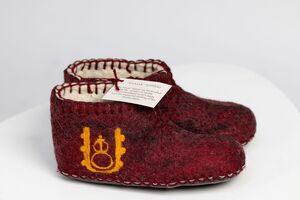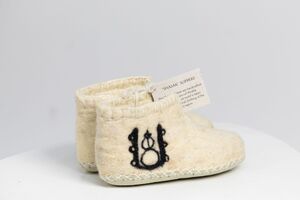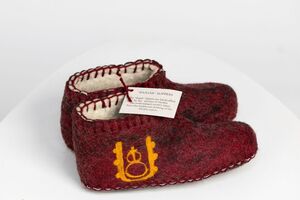Woolen Slippers (shajak) – Ethnographic motives of traditional clothing
The shajak slippers, in their rare craftsmanship, create an unforgettable harmony of heritage and creativity. This form of craftsmanship is a reflection of the skills of the masters, who connect elements of tradition by interweaving them with elements of modernity. To bring these wonderful handicrafts, the wool is first selected and treated with the utmost care. The selection of materials is an important process, where the wool used is of the highest quality, carefully chosen to ensure a good basis for the future work and a quality for the souvenir that will be created.
To produce the unique shape of the dolls, artisans use special, hand-crafted, wooden, and carefully selected molds or molds. After determining the molds, which are based on the size we want to produce the slippers, we begin to cover them with thin layers of wool. The thickness of the applied wool depends on the design and the aesthetic effect that is desired to be obtained at the end.
To ensure a perfect and stable coloring, natural colors are used, in this case red and black were used. The preparation of colors requires deep knowledge of these natural pigments and skills in conveying them as well as possible in the material. This is a stage where the craftsman shows his skill in using colors to create visual effects that depict stories and emotions.
Once the fur is applied and the coloring is done to perfection, it's time to create the shape and texture of the pupa. This is a process that requires the same dedication where the artisan uses his hand and the sensitivity of touch to give the final shape and personality of the pupa. The thin stocking, chosen for its elasticity, helps shape the fur and create the desired shajak texture.
A critical element in the creation of handmade dolls is the drying process of the materials. Care and patience at this stage are essential to ensure that each piece stays in shape and meets high quality standards.
Për të krijuar një vepër të mirë artizanale, pjesa e papuçes pritet dhe e bashkohet me kujdes me pjesën e poshtme përmes qepjes. Qepja është një proces delikat dhe preciz, ku aftësitë e artizanit shkëlqejnë në bashkimin e materialeve në një harmoni të plotë. Për pjesën e poshtëme të pupave është përdorur lëkurë ekologjike, në këtë rast e njëjta ngjyrë me vetë shajakun. Për qepjen e të dyave është përdorur fije leshi me të njëjtën ngjyrë.
Në pjesën anësore të sejcilës pupë, është sjellë një motiv I qëndisur me gjilpërë shajaku dhe marrë nga veshjet popullore të mirditës. Me qëllim evidentimin e motivit, mbi pupat e zeza, motivi është realizuar me të bardhë, mbi pupat e kuqe motivi është potokalli dhe mbi pupat e bardha ai është realizuar me lesh të zi. Motivi zë një sipërfaqe 6.6x7.5cm.
Në fund, vepra artizanale e pupave të shajakut është më shumë se një produkt artizanali - ajo është një pasqyrë e trashëgimisë kulturore materiale, një ndërthurje e traditës dhe krijimtarisë së palëkundur. Çdo pjesë e këtyre pupave përshkon një udhëtim të gjatë të imagjinatës dhe kujtdo që i shikon ato ndjehet i përfshirë në një histori të fshehur, që rrëfehet me ngjyrat dhe formën e saj unike.



